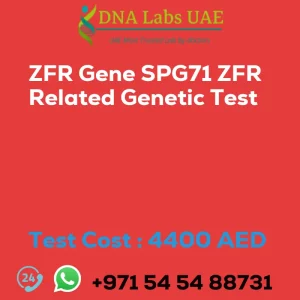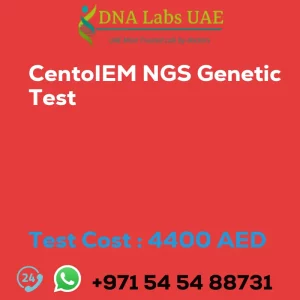TBP Gene Spinocerebellar Ataxia Type 17 Autosomal Dominant Genetic Test
Test Name: TBP Gene Spinocerebellar Ataxia Type 17 Autosomal Dominant Genetic Test
Components: Blood or Extracted DNA or One drop Blood on FTA Card
Price: 4400.0 AED
Sample Condition: Blood or Extracted DNA or One drop Blood on FTA Card
Report Delivery: 3 to 4 Weeks
Method: NGS Technology
Test Type: Neurological Disorders
Doctor: Neurologist
Test Department: Genetics
Pre Test Information: Clinical History of Patient who is going for TBP Gene Spinocerebellar Ataxia Type 17, Autosomal Dominant NGS Genetic DNA Test. A Genetic Counselling session to draw a pedigree chart of family members affected with TBP Gene Spinocerebellar Ataxia Type 17, Autosomal Dominant.
Test Details: Spinocerebellar Ataxia Type 17 (SCA17) is a rare neurodegenerative disorder characterized by progressive ataxia, which is the lack of muscle coordination, and other neurological symptoms. It is caused by a mutation in the TBP gene, which is involved in the regulation of gene expression. An autosomal dominant NGS genetic test for SCA17 refers to a Next-Generation Sequencing (NGS) test that analyzes the TBP gene to identify mutations or variants that may be associated with SCA17. This type of genetic test can help confirm a diagnosis of SCA17 in individuals who have symptoms of the condition and may also be used for carrier testing in individuals with a family history of SCA17. NGS technology allows for the simultaneous analysis of multiple genes, making it a powerful tool for genetic testing. In the case of SCA17, the NGS test would specifically focus on sequencing the TBP gene to identify any disease-causing mutations or variants. The test typically involves collecting a blood or saliva sample from the individual, which is then sent to a laboratory for analysis. The laboratory will use NGS technology to sequence the TBP gene and compare the results to a reference sequence to identify any genetic variations. It is important to note that a positive genetic test result for SCA17 does not necessarily mean that an individual will develop symptoms of the condition. The onset and severity of symptoms can vary widely among affected individuals, even within the same family. Genetic testing can, however, provide valuable information for diagnosis, prognosis, and family planning purposes. Genetic counseling is often recommended both before and after genetic testing to help individuals understand the implications of the test results and make informed decisions.
| Test Name | TBP Gene Spinocerebellar ataxia type 17 autosomal dominant Genetic Test |
|---|---|
| Components | |
| Price | 4400.0 AED |
| Sample Condition | Blood or Extracted DNA or One drop Blood on FTA Card o |
| Report Delivery | 3 to 4 Weeks |
| Method | NGS Technology |
| Test type | Neurological Disorders |
| Doctor | Neurologist |
| Test Department: | Genetics |
| Pre Test Information | Clinical History of Patient who is going for TBP Gene Spinocerebellar ataxia type 17, autosomal dominant NGS Genetic DNA Test A Genetic Counselling session to draw a pedigree chart of family members affected with TBP Gene Spinocerebellar ataxia type 17, autosomal dominant |
| Test Details |
Spinocerebellar ataxia type 17 (SCA17) is a rare neurodegenerative disorder characterized by progressive ataxia, which is the lack of muscle coordination, and other neurological symptoms. It is caused by a mutation in the TBP gene, which is involved in the regulation of gene expression. An autosomal dominant NGS genetic test for SCA17 refers to a Next-Generation Sequencing (NGS) test that analyzes the TBP gene to identify mutations or variants that may be associated with SCA17. This type of genetic test can help confirm a diagnosis of SCA17 in individuals who have symptoms of the condition and may also be used for carrier testing in individuals with a family history of SCA17. NGS technology allows for the simultaneous analysis of multiple genes, making it a powerful tool for genetic testing. In the case of SCA17, the NGS test would specifically focus on sequencing the TBP gene to identify any disease-causing mutations or variants. The test typically involves collecting a blood or saliva sample from the individual, which is then sent to a laboratory for analysis. The laboratory will use NGS technology to sequence the TBP gene and compare the results to a reference sequence to identify any genetic variations. It is important to note that a positive genetic test result for SCA17 does not necessarily mean that an individual will develop symptoms of the condition. The onset and severity of symptoms can vary widely among affected individuals, even within the same family. Genetic testing can, however, provide valuable information for diagnosis, prognosis, and family planning purposes. Genetic counseling is often recommended both before and after genetic testing to help individuals understand the implications of the test results and make informed decisions. |







